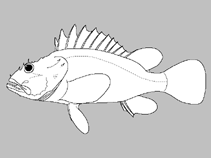Hochladen Photos und videos
Google BildNo image available for this species;
drawing shows typical species in Scorpaenidae.
Google BildNo image available for this species;
drawing shows typical species in Scorpaenidae.
Klassifizierung / Names Namen | Synonyme | Catalog of Fishes(Gattung, Arten) | ITIS | CoL | WoRMS | Cloffa
> Perciformes/Scorpaenoidei (Scorpionfishes) > Scorpaenidae (Scorpionfishes or rockfishes) > Scorpaeninae
Etymology: Scorpaena: Latin, scorpaena = a kind of fish, 1706 (Ref. 45335); regina: Named for Queensland (‘regina’ for queen), referring to its type.
Etymology: Scorpaena: Latin, scorpaena = a kind of fish, 1706 (Ref. 45335); regina: Named for Queensland (‘regina’ for queen), referring to its type.
Environment: milieu / climate zone / depth range / distribution range Ökologie
seewasser; tiefenbereich 2 - 57 m (Ref. 121601). Tropical
Verbreitung Länder | FAO Gebiete | Ecosystems | Vorkommen | Point map | Einführungen | Faunafri
Western Pacific: Australia.
Size / Gewicht / Alter
Kurzbeschreibung Bestimmungsschlüssel | Morphologie | Morphometrie
Rückenflossenstacheln (insgesamt) : 7; Rückenflossenweichstrahlen (insgesamt) : 9; Afterflossenstacheln: 3; Afterflossenweichstrahlen: 5; Wirbelzahl: 24. This species is distinguished by the following set of characters: D 9; pectoral-fin rays 13-17 (mode 16); scale rows in longitudinal series 39-46 (41-42); pored lateral-line scales 21-24 (23); scales above lateral line 5-7 (6) and below 11-14 (12); scale rows between sixth dorsal-fin spine base and lateral line 5-6; scale rows between last dorsal-fin spine base and lateral line 5-6; pre-dorsal scale rows 4-7 (4-5); gill rakers on upper limb 4-5, lower limb 9-12 (10) [7-9 (8) rakers on ceratohyal and 1-3 (2) on hypobranchial], total rakers 13-17 [14-15 (3 paratypes); rarely 16-17 (1) of all paratypes]; ctenoid scales on lateral surface of body; cycloid scales exposed (or embedded in thin skin) covering the anteroventral surface of body and pectoral-fin base; lateral surface of maxilla no longitudinal ridge; lateral surface and dorsal margin of lacrimal no spines (2 paratypes with lateral lacrimal spine and vertical spine on dorsal margin of lacrimal, respectively); anterior lacrimal spine simple (1 paratype with a small spinous point on posterior margin); posterior lacrimal spine simple, directed posteroventrally; no median interorbital ridge nor coronal spine; with occipital pit and supplementary preopercular spine; simple pterotic spine; posterior tip of pectoral fin do not reach vertical through first anal-fin spine base; first anal-fin spine base located slightly posterior to vertical through last dorsal-fin spine base; prepelvic-fin length 36.3-43.0 (mean 39.8) % of SL; 9th and 10th dorsal-fin spine lengths 8.9-13.3 (11.1) % of SL and 6.5-10.1 (8.4) % of SL, respectively; caudal peduncle depth 10.5-12.3 (11.3) % of SL; the space between upper and lower opercular spines is covered by thin skin with small sensory pores; underside of lower jaw smooth, no tentacles; supraocular tentacle length variable, the longest approximately equal to orbit diameter; several distinct slender tentacles (associated with pored lateral-line scales) scattered on lateral surface of body (Ref. 121601).
Collection data of specimens of blackish form indicates a coral reef habitat, usually at depths less than 20 m, and specimens of yellowish form were collected from deeper sandy bottom areas below 30 m depth (Ref. 121601).
Life cycle and mating behavior Geschlechtsreife | Fortpflanzung | Ablaichen | Eier | Fecundity | Larven
Hauptreferenz
Upload your references | Referenzen | Koordinator | Partner
Wibowo, K., J.W. Johnson and H. Motomura, 2019. Scorpaena regina, a new scorpionfish (Teleostei: Scorpaenidae) from the east coast of Queensland, Australia. Zootaxa 4706(2):296-310. (Ref. 121601)
CITES
Not Evaluated
Bedrohung für Menschen
Harmless
Nutzung durch Menschen
FAO - Publication: search | FishSource |
Mehr Information
Trophic ecology
Nahrungsorganismen
Nahrungszusammensetzung
Nahrungsaufnahme
Food rations
Räuber
Nahrungsorganismen
Nahrungszusammensetzung
Nahrungsaufnahme
Food rations
Räuber
Ecology
Ökologie
Ökologie
Population dynamics
Growth parameters
Max. ages / sizes
Length-weight rel.
Length-length rel.
Längenhäufigkeiten
Mass conversion
Rekrutierung
Dichte
Growth parameters
Max. ages / sizes
Length-weight rel.
Length-length rel.
Längenhäufigkeiten
Mass conversion
Rekrutierung
Dichte
Life cycle
Fortpflanzung
Geschlechtsreife
Maturity/Gills rel.
Fecundity
Ablaichen
Spawning aggregations
Eier
Eientwicklung
Larven
Larven Pop.Dyn.
Fortpflanzung
Geschlechtsreife
Maturity/Gills rel.
Fecundity
Ablaichen
Spawning aggregations
Eier
Eientwicklung
Larven
Larven Pop.Dyn.
Anatomy
Kiemenoberfläche
Brain
Otolith
Kiemenoberfläche
Brain
Otolith
Physiology
Body composition
Nutrients
Oxygen consumption
Swimming type
Swimming speed
Visual pigments
Fish sound
Diseases & Parasites
Toxicity (LC50s)
Body composition
Nutrients
Oxygen consumption
Swimming type
Swimming speed
Visual pigments
Fish sound
Diseases & Parasites
Toxicity (LC50s)
Genetics
Genetik
Heterozygosity
Vererbbarkeit
Genetik
Heterozygosity
Vererbbarkeit
Human related
Aquaculture systems
Aquakultur Profile
Zuchtlinien
Ciguatera cases
Stamps, coins, misc.
Aquaculture systems
Aquakultur Profile
Zuchtlinien
Ciguatera cases
Stamps, coins, misc.
Tools
E-book | Feldführer | Längenhäufigkeits Tool | Lebensdaten Tool | Punkt Karte | Classification Tree
| Catch-MSY |
Zusatzinformationen
Download XML
Zusammenfassung | Point data | Namen | Photos
Internet Quellen
AFORO (otoliths) | Aquatic Commons | BHL | Cloffa | BOLDSystems | Websites from users | FishWatcher Einträge suchen | CISTI | Catalog of Fishes: Gattung, Arten | DiscoverLife | ECOTOX | FAO - Publication: search | Faunafri | Fishipedia | Fishtrace | GenBank: Genom, nucleotide | GloBI | Google Books | Google Scholar | Google | IGFA World Record | MitoFish | Otolith Atlas of Taiwan Fishes | PubMed | Reef Life Survey | Socotra Atlas | Tree of Life | Wikipedia: Gehe zu, Suchen | World Records Freshwater Fishing | Zoobank | Zoological Record
Estimates based on models
Phylogenetic diversity index (Ref. 82804): PD50 = No PD50 data [Uniqueness, from 0.5 = low to 2.0 = high].
Bayesian length-weight: a=0.01318 (0.00635 - 0.02739), b=3.02 (2.85 - 3.19), in cm total length, based on LWR estimates for this Genus-body shape (Ref. 93245).
Trophic level (Ref. 69278): 3.4 ±0.2 se; based on size and trophs of closest relatives
Widerstandsfähigkeit (Ref. 120179): hoch, Verdopplung der Population dauert weniger als 15 Monate. (Preliminary K or Fecundity.).
Fishing Vulnerability (Ref. 59153): Low vulnerability (10 of 100).




